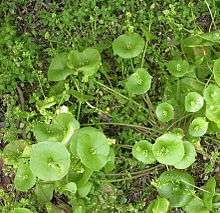Claytonia perfoliata
| Claytonia perfoliata | |
|---|---|
| Claytonia perfoliata subsp. perfoliata in Washington Park, Anacortes, Washington | |
| Scientific classification | |
| Kingdom: | Plantae |
| Clade: | Angiosperms |
| Clade: | Eudicots |
| Order: | Caryophyllales |
| Family: | Montiaceae |
| Genus: | Claytonia |
| Species: | C. perfoliata |
| Binomial name | |
| Claytonia perfoliata | |
| Synonyms[1] | |
| |
Claytonia perfoliata (syn. Montia perfoliata), also known as Indian lettuce, spring beauty, winter purslane, or miner's lettuce, is a flowering plant in the Montiaceae family. It is a fleshy, herbaceous annual plant native to the western mountain and coastal regions from southernmost Alaska and central British Columbia all the way south to Central America, but most common in California in the Sacramento and northern San Joaquin Valleys.
Together with Claytonia parviflora and Claytonia rubra, C. perfoliata comprises what is almost certainly a polyploid pillar complex based on three diploid species.[2] Two key studies on the population ecology and genetics of the C. perfoliata complex were published in 2012.[3][4]
Description
Claytonia perfoliata is a tender rosette-forming plant that grows to a maximum of 40 centimetres (16 in) in height, but mature plants can be as short as 1 centimetre (0.39 in). The cotyledons are usually bright green (rarely purplish- or brownish-green), succulent, long and narrow. The first true leaves form a rosette at the base of the plant, and are 0.5 to 4 centimetres (0.20 to 1.57 in) long, with a typically long petiole (exceptionally up to 20 centimetres (7.9 in) long).
The small pink or white flowers have five petals 2 to 6 millimetres (0.079 to 0.236 in) long. The flowers appear from February to May or June, and are grouped 5–40 together. The flowers grow above a pair of leaves that are connected together around the stem so as to appear as a single circular leaf. Mature plants form a rosette; they have numerous erect to spreading stems that branch from the base.
C. perfoliata is common in the spring time, and prefers a cool, damp environment. The plant first appears in sunlit areas after the first heavy rains of the year, though the best stands are found in shaded areas, especially in the uplands, into early summer. As the days get hotter and drier, the leaves turn a deep red color as they dry out.
Subspecies
There are three well-studied geographical subspecies of C. perfoliata:[5]
- Claytonia perfoliata subsp. perfoliata: Pacific coastal United States and southwest Canada
- Claytonia perfoliata subsp. intermontana: interior western United States
- Claytonia perfoliata subsp. mexicana: coastal southern California and Arizona, all the way south to Mexico to Guatemala
Uses
The very common name of "miner's lettuce" refers to how the plant was used by California Gold Rush miners, who ate it to prevent scurvy. It can be eaten as a leaf vegetable. Most commonly, it is eaten raw in salads, but it is not quite as delicate as actual lettuce that is cultivated. Sometimes it is boiled like spinach, which it resembles in taste and chemical composition. Caution: C. perfoliata can sometimes accumulate toxic amounts of soluble oxalates.[6]
It has been widely naturalized in western Europe, after being introduced there in the eighteenth century, possibly by the naturalist Archibald Menzies, who brought it to Kew Gardens in London in 1794.[7][8]
- Flower petals are 2 to 6 millimetres (0.079 to 0.236 in) long

 Cauline leaves are perfoliate
Cauline leaves are perfoliate
References
- ↑ "The Plant List: A working list of all plant species". Royal Botanic Gardens Kew and Missouri Botanic Garden. Retrieved 8 May 2016.
- ↑ Miller, J. M. and K. L. Chambers. 2006. Systematics of Claytonia (Portulacaceae). Systematic Botany Monographs 78: 1-236 ISBN 0-912861-78-9
- ↑ McIntyre, P. J. 2012. Cytogeography and genome size variation in the Claytonia perfoliata (Portulacaceae) polyploid complex. Annals of Botany (Oxford) 110(6): 1195-203.
- ↑ McIntyre, P. J. 2012. Polyploidy associated with altered and broader ecological niches in the Claytonia perfoliata (Portulacaceae) species complex. American Journal of Botany 99(4): 655-62.
- ↑ Miller, J. M and K. L. Chambers. 2006. Systematics of Claytonia (Portulacaceae). Systematic Botany Monographs 78: 1-236. ISBN 0-912861-78-9
- ↑ "Miner's Lettuce". UC IPM Online. UC Davis.
- ↑ Hank Shaw (March 7, 2011). "Foraging for Miner's Lettuce, America's Gift to Salad". The Atlantic. Retrieved 2013-04-06.
- ↑ Archibald Menzies (1923). Menzies' Journal of Vancouver's Voyage, April to October, 1792 [extract]. W. H. Cullin Printers. Retrieved 2013-04-07.
- McIntyre, P. J. 2012. Cytogeography and genome size variation in the Claytonia perfoliata (Portulacaceae) polyploid complex. Annals of Botany (Oxford) 110(6): 1195-203.
- McIntyre, P. J. 2012. Polyploidy associated with altered and broader ecological niches in the Claytonia perfoliata (Portulacaceae) species complex. American Journal of Botany 99(4): 655-62.
External links


- Flora North America Claytonia perfoliata
- Calflora database: Claytonia perfoliata (Miner's lettuce)
- Jepson Flora Project: Claytonia perfoliata
- Plants of British Columbia: Claytonia perfoliata